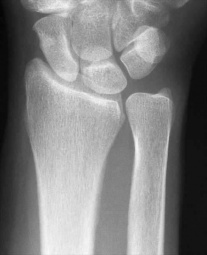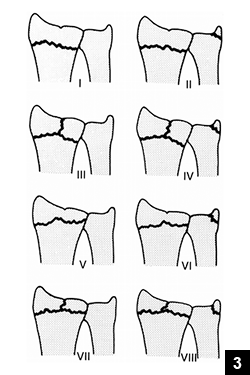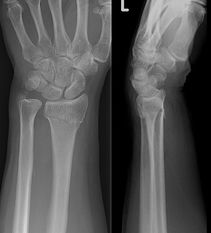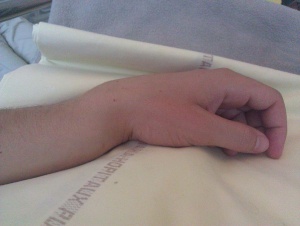Colles Fracture
Original Editor - Stacy S Stone
Top Contributors - Emma Guettard, Admin, Adam Vallely Farrell, Kim Jackson, Stacy S Stone, Laura Ritchie, Rachael Lowe, Anne-Laure Vanherwegen, Nikhil Benhur Abburi, Lauren Lopez, Lucinda hampton, Claire Knott, Anas Mohamed, Evan Thomas, Scott Buxton, Priyanka Chugh, Benjamin Desmedt and WikiSysop - Emma Guettard as part of the Vrije Universiteit Brussel Evidence-based Practice Project
Definition/Description[edit | edit source]
A Colles Fracture is a complete fracture of the radius bone of the forearm close to the wrist resulting in an upward (posterior) displacement of the radius and obvious deformity. It is commonly called a “broken wrist” in spite of the fact that the distal radius is the location of the fracture, not the carpal bones of the wrist.[1]
The Colles fracture is named after Abraham Colles, an Irish surgeon, who first described it in 1814 by simply looking at the classical deformity before the advent of X-rays
The fracture originates from a fall on the outstretched hand and is usually associated with dorsal and radial displacement of the distal fragment, and disturbance of the radial-ulnar articulation. Possibly the ulnar styloid may be fractured. Communication of the distal fragment and fractures into the joint surface is present in some of these fractures. The colles fracture is one of the most common and challenging of the outpatient fractures[2]. Colles' fracture is defined as a linear transverse fracture of the distal radius approximately 20-35 mm proximal to the articular surface with dorsal angulation of the distal fragment[3]. The below brief video gives a summary of Colles Fractures.
Clinical Relevant Anatomy[edit | edit source]

The distal radius forms the proximal side of the wrist joint. There, the radius articulates with the proximal row of carpal bones (allowing flexion and extension); it also articulates with the distal ulna (creating a joint for pronation and supination).
The distal ulna attaches to a meniscus-like structure, the triangular fibrocartilage discus (TFC), which can be torn with wrist fractures.
On the lateral side of the radius is a styloid process, onto which the brachioradialis inserts and from which the radial collateral ligament of the wrist originates.
At the distal metaphysis of the radius, the cortex of the bone is thinner than the bone proximal and distal, and the relative amount of cancellous bone increases. The distal metaphysis of the radius is therefore a relative weak point. This make fractures more likely, especially in patients with decreased bone mineral density.[6]
Low energy extra-articular fracture of the distal radius. Can be associated with ulnar styloid fracture, TFCC (triangular fibrocartilage complex)tear, scapholunate dissociation.[7]
For further information on the Anatomy and assessment of the wrist
Epidemiology/Etiology[edit | edit source]
It is known that these fractures appear mostly by young adults and the elderly[8] and more often in females compared to males, often there is a history of osteoporosis. In the United States and in Northern Europe, Colles fractures are the most common fractures in women up to the age of 75 years[9]. Stable Colles' fractures present with minimal comminution. Unstable fractures are distinctly comminuted often with corresponding avulsions of the radial or ulnar styloid, that have the potential to cause compression neuropathies, especially of the median nerve. Other complications that have been reported are degenerative joint disease and reflex sympathetic dystrophy[3].
Colles fractures are the most common type of distal radial fracture and are seen in all adult age groups and demographics. They are particularly common in patients with osteoporosis, and as such, they are most frequently seen in elderly women and particularly from simply falling on an outstretched hand in a ground-level fall. The relationship between Colles fractures and osteoporosis is strong enough that when an older male patient presents with a Colles fracture, he should be investigated for osteoporosis because his risk of a hip fracture is also elevated. [10] An increasing awareness of osteoporosis has led to these injuries being termed fragility fractures, with the implication that a workup for osteoporosis should be a standard part of treatment. As the population lives longer, the frequency of this type of fracture will increase.
Younger patients have stronger bone, and thus, more energy is required to create a fracture in these individuals. Younger patients who sustain Colles fractures have usually been involved in high impact trauma or have fallen, e.g. during contact sports, skiing, horse riding[10], motorcycle accidents, falls from a height.
Characteristics/Clinical Presentation[edit | edit source]
The clinical presentation of Colles fracture is commonly described as a dinner fork deformity. A distal fracture of the radius causes posterior displacement of the distal fragment, causing the forearm to be angled posteriorly just proximal to the wrist. With the hand displaying its normal forward arch, the patient’s forearm and hand resemble the curvature of a dinner fork.
- "Dinner Fork" Deformity[11]
- History of fall on an outstretched hand
- Dorsal wrist pain
- Swelling of the wrist
- Increased angulation of the distal radius
- Inability to grasp object[12]
Signs and Symptoms- Pain, numbness, tenderness, bruising, deformity of wrist.
Frykman Classification[edit | edit source]

Gosta Frykman identified many different forms of Colles fracture and classified it into eight different types based on the extra- or intra-articular nature of fractures involving the distal ends of the radius and ulna.
- Type I: transverse metaphyseal fracture
- includes both Colles and Smith fractures as angulation is not a feature
- Type II: type I + ulnar styloid fracture
- Type III: fracture involves the radiocarpal joint
- includes both Barton and reverse Barton fractures
- includes Chauffeur fractures
- Type IV: type III + ulnar styloid fracture
- Type V: transverse fracture involves distal radioulnar joint
- Type VI: type V + ulnar styloid fracture
- Type VII: comminuted fracture with the involvement of both the radiocarpal and radioulnar joints
- Type VIII: type VII + ulnar styloid fracture[14][15]
Although it appears complicated, there is only a four-type classification (odd-numbered types) with each type having a subtype which includes ulnar styloid fracture (the even-numbered types)
Patients frequently heal well with no complications. If the displacement of the Colles fracture is seen a few weeks after reduction, it's important to take and check radiographs a week-10 days after injury. Possible complications may include:
- Malunion
- Persistent translation of the carpus
- Shortening of radius
- Stiffness of the wrist and the forearm
Few very rare complications are carpal tunnel syndrome, Sudeck's atrophy and ulnar and radial compression neuropathy.[16]
Diagnosis[edit | edit source]

A careful history including the mechanism of injury establishes suspicion for a Colles fracture. Diagnosis is most often made upon interpretation of posteroanterior and lateral views alone.[18]
The classic Colles fracture has the following characteristics;
- Transverse fracture of the radius
- 2.5 cm (0.98 inches) proximal to the radiocarpal joint
- dorsal displacement and dorsal angulation, together with the radial tilt
Other characteristics on plain radiographs may include:
- Radial shortening
- Loss of ulnar inclination
- Radial angulation of the wrist
- Comminution at the fracture site
- Associated fracture of the ulnar styloid process in more than 60% of cases.[19]
Differential Diagnosis/ Associated Injuries[edit | edit source]
- Scapholunate ligament tear
- Median nerve injury
- TFCC (triangular fibrocartilage complex) injury, up to 50% when ulnar styloid fx also present
- Carpal ligament injury: Scapholunate Instability(most common), lunotriquetral ligament
- Tendon injury, attritional EPL rupture, usually treated with EIP tendon transfer
- Compartment syndrome
- Ulnar styloid fracture
- DRUJ (Distal Radial Ulnar Joint) Instability
- Galeazzi Fracture: highly associated with distal 1/3 radial shaft fractures[20]
Outcome Measures[edit | edit source]
Medical Management[edit | edit source]
The treatment of Colles fractures will depend on the type of Colle's fracture present, the age and activity level of the patient, the surgeon’s preference, and the patient’s desires regarding immobilisation and return to activity. As Colles fractures are so common, many methods of treatment have been developed to stabilize the fractures and allow the bone to heal. The ultimate goal is to return the wrist to its prior level of functioning.
Management of a Colle's fracture depends on the severity of the fracture. An undisplaced fracture may be treated conservatively with a cast alone. The cast is applied with the distal fragment in palmar flexion and ulnar deviation.
Surgical options can include external fixation, internal fixation, percutaneous pinning, and bone substitutes.
A fracture with mild angulation and displacement may require closed reduction. Significant angulation and deformity may require an open reduction and internal fixation or external fixation. The volar forearm splint is best for temporary immobilisation of forearm, wrist and hand fractures, including Colles fracture.
A higher amount of instability criteria increases the likelihood of operative treatment.
The fracture pattern, degree of displacement, the stability of the fracture, and the age and physical demands of the patient will all be considered when determining the best treatment option[24][25]
Physical Therapy Management[edit | edit source]
Many patients will present to a physiotherapist with pain, oedema, decreased range of motion, decreased strength, and decreased functional abilities.[26] Once a Colles’ fracture has healed rehabilitation is recommended in an attempt to restore function and strength to the fractured wrist. The primary focus in early rehabilitation is to mobilise the wrist, which is indicated approximately 7-8 weeks post-fracture.[26][27] If the fracture has been managed using an internal fixation device, early mobilisation can begin as early as 1-week post-surgery.[28] Caution should be paid to fractures that have been treated with external fixation as the wrist is often held in a pronated position. This can predispose the patient to a contracture at the distal radioulnar joint.[29] Other soft tissue injuries that may affect rehabilitation progress include; oedema, cast impingement, infection, osteomyelitis, adherent scar, intrinsic or extrinsic muscle tightness, joint capsular tightness, neurovascular injury, ligament injury, and post-traumatic arthritis.[26]
Initial Rehabilitation[edit | edit source]
One of the primary goals in early rehab is to restore normal range of motion (ROM) at the wrist with both passive ROM and progression to active ROM. Wrist flexion and extension are often the first motions emphasised working within the patient's pain-free available range.[28] The addition of ROM exercises helps to limit scar tissue and adhesion formation that commonly occur after surgery. It is also important to emphasise motion at the joints above and below (shoulder, elbow, and fingers) during all phases of rehab. One of the primary focuses in early rehab is to limit the pain and the amount of oedema present in the wrist and hand region.[27]
Sub-Acute Phase[edit | edit source]
The next phase of rehab in the treatment of Colles’ fracture continues to focus on increasing wrist ROM and the commencement of strengthening exercises. For fractures that were surgically treated, ROM should be regained between 6 to 8 weeks post-op.[30] Examples of ROM exercises that can be performed include:
- Wrist flexion/extension
- Radial/ulnar deviation
- Pronation/supination
- Making a fist and opening.[30]
In the sub-acute phase, ROM exercises can progress into strengthening by performing all exercises with a weight in the hand or performing grip squeeze with a foam ball or a towel roll. During strengthening, it is important to address all forearm muscles but also the extrinsic and intrinsic hand muscles progressively building resistance as the individual gets stronger[27]. During this phase, progressive stretching can begin to increase available ROM. Each stretch should be held for 30-60 seconds for 3 repetitions. If the patient is unable to tolerate a slow, prolonged stretch, shorter stretches of 10 seconds can be performed for 10 repetitions.[31]
Modalities[edit | edit source]
Heat/Paraffin Wax[edit | edit source]
Heat whether in the form of a heat pack or paraffin wax can be very beneficial in the early stages to increase ROM and decrease pain.[32][33] It is often used with cold therapy to improve venous return.[34]
Massage[edit | edit source]
Massage to reduce scar tissue and retrograde massage to reduce swelling are two effective modalities used in rehabilitation post Colles fracture. The benefit is that can also be taught to the patient to continue independently when in their own homes.[33][35]
Cryotherapy[edit | edit source]
Cryotherapy is an effective modality for controlling oedema in the acute phase after trauma and during rehabilitation due to its ability in helping to decrease blood flow through vasoconstriction limiting the amount of fluid escaping from capillaries to the interstitial fluid[36]. Cryotherapy can also be combined with compression and elevation in the treatment of oedema.[37] To control pain using cryotherapy, the modality should be applied to the area for 10-15 minutes which can result in pain control up to 2 hours post-application.[37] Precautions for the use of cryotherapy include: over a superficial branch of the nerve, over an open wound, poor sensation or mentation, and very young or very old patients.[37] Contraindications for cryotherapy include; Acute febrile illness, Vasospasm e.g. Raynaud’s disease, Cryoglobinaemia, Cold urticaria.[38]
Electrical Stimulation[edit | edit source]
The use of transcutaneous electrical nerve stimulation (TENS) may be used as an adjunct during any phase of rehab to address pain but can be particularly useful for patients that are increasing the level of activity of the wrist. Conventional (high-rate) TENS is useful for disrupting the pain cycle through a prolonged treatment session as great as 24 hours a day.[36] Low-rate TENS is another form of electrical stimulation that is successful in diminishing pain by targeting motor or nociceptive A-delta nerves. Low-rate TENS has been reported to be effective in pain control for up to 4-5 hours post-treatment.[37]
The literature is still not conclusive on this topic and the results of one study may contradict or, on the contrary, reinforce the results of another study. Yet there is evidence supporting the beneficial effects of electrical stimulation, especially in combination with physiotherapy exercises.
Exercise[edit | edit source]
Exercise is beneficial in the restoration of range and also vital to strengthen the hand, wrist, elbow and shoulder. Immobility at the wrist has a huge effect on the range of movement and power. Exercises to increase ROM can be as simple as walking the hand up the wall, whereas exercises such as tearing paper, writing and drawing are great for strengthening the wrist and for improving the strength and dexterity of the hand. Being able to use opposition and pinching are vital for improving function and regaining independence in ADLs[34]. Even simple tasks like buttoning a shirt can be difficult after a Colles fracture.
Suggested Guidelines for the Conservative and Non-Conservative Management of a Colles Fracture[edit | edit source]
In a paper by Pho et al they suggested definitive guidelines for the management of conservative and non-conservative treatment of a Colles fracture[39].
In the conservative management of Colles fractures they recommend dividing rehabilitation into three stages, acute, sub-acute and settled. The acute stage (0-8 weeks) focuses on protection with a short-arm cast, controlling pain and oedema and maintaining the range of the digits, elbow and shoulder. Once the cast is removed, the sub-acute stage, the aim is to control pain and oedema (TENS, ice), increase range of movement and increase activities of daily living (ADLs). In the final, settled, stage the goal of rehabilitation is to regain full ROM, incorporate strengthening and return to normal activity.[39]
Where conservative management is not an option they again suggest the same three stages as for conservative management but the timescales differ. The acute stage begins in week 1 and ends at week 6. During this stage, the aim of any intervention focuses on controlling pain and oedema (TENS, ice), protection of the surgical site and maintaining ROM of the digits, elbow, shoulder. The next, sub-acute, stage (7-10 weeks) emphasis is on protecting the fracture site, controlling pain and oedema (TENS, ice) and the ROM of both the involved and uninvolved joints. [39] In the final, settled, stage the goals are the same as conservative management, regain full ROM, begin strengthening and increase tolerance of ADLs with the aim of returning to normal activity[39]
Case Study[edit | edit source]
A case report used a rehabilitation protocol to improve range of motion and grip strength in an undisplaced, stable Colles' fracture. The patient got a treatment with passive interventions to improve circulation and prevent immobilisation adhesion formation. These treatments included the application of an ice pack to reduce oedema followed by application of a wax bath on the affected wrist. Gentle range of motion mobilisations were then introduced that could only be performed in flexion and extension to the patient's pain tolerance. Three sets of 5 flexion/extension repetitions were performed on the affected wrist. The joint was also mobilised in circumduction, ulnar flexion and radial flexion to the patient's level of tolerance.
Early mobilisation resulted in the rapid recovery of both movement and strength without causing more discomfort or adversely influencing the progression of the deformity. In patients over 55, minimally displaced fractures can safely be treated in a crepe bandage, and displaced fractures which have been reduced can be treated in a modified cast. Early mobilisation would ensure rapid recovery of wrist and hand function while avoiding the complications of a conventional plaster cast[40].
This study [40] proved that in the groups with displaced and undisplaced fractures, the recovery of forearm rotation and finger movement paralleled the recovery of wrist movement: for both types of fracture, early mobilisation led to an earlier return of strength. Although this recovery did not parallel the improvement in wrist movement.
In both categories early mobilisation led to more rapid resolution of wrist swelling in the first five weeks. At nine weeks and at 13 weeks the wrist girths were similar.
Patients encouraged to mobilise the injured wrist from the outset recovered wrist movement more quickly than those who were immobilised in a conventional plaster cast.[40]
Supervised Active Rehabilitation Program Used in the Study[edit | edit source]
- ISOMETRIC EXERCISE
- Wrist flexors and extensors
- ACTIVE RANGE OF MOTION EXERCISE
- Assisted stretch to forearm flexors and extensor musculature and radial/ulnar deviation
- Weight-bearing wrist extension exercise(hand on the table with the patient leaning forward on them) to patient tolerance
- Active stretch to the shoulder girdle and rotator cuff musculature
- Active stretch to elbow flexor and extensor musculature
- INTRINSIC HAND MUSCLE EXERCISE
- Thumb/digit opposition
- The Repetitive squeezing of theraputty
- Repetitive towel wringing exercise
- STRENGTHENING ROUTINE
- Biceps curl with 1,5-2 pound weights bilaterally
- Shoulder abduction, flexion and extension reps with 2-pound weights bilaterally
- The Repetitive squeezing of a rubber ball in the affected wrist
- Flexion and extension of the wrist using 1.5-pound weights increasing as tolerated
- FUNCTIONAL ACTIVITIES
- The Patient is encouraged to resume pre-accident activities that involve the affected extremity (eg. writing, typing, cooking, etc.)
References[edit | edit source]
- ↑ http://www.handandwristinstitute.com/colles-fracture/
- ↑ T. M. Molder, E. Vernon Stabler, M.D., and William H. Cassebaum,M.D.; Colles fracture: evaluation and selection of the therapy; the journal of trauma and acute case surgery. 1965; volume 5 issue 4.(Level of Evidence 1B)
- ↑ 3.0 3.1 Stephen Balsky, Rehabilitation protocol for undisplaced Colles' fractures following cast removal, the journal of the Canadian chiropractic association.(Level of evidence 4)
- ↑ Physio vibes Colles fracture Available from:https://www.youtube.com/watch?v=250hYdgaegI (last accessed 6.12.2019)
- ↑ http://emedicine.medscape.com/article/1245884-overview#a11
- ↑ http://www.orthopaedicsone.com/display/MSKMed/Distal+radius+%28Colles%29+fractures
- ↑ 7.0 7.1 MacDermid JC, Roth JH, Richards RS. Pain and disability reported in the year following a distal radius fracture: a cohort study. BMC Musculoskeletal Disord. 2003;4:24.
- ↑ Cummings SR, Kelsey JL, Nevitt MC, O’Dowd KJ., Epidemiology of osteoporosis and osteoporotic fractures. Epidemiol Rev. 1985;7:178–208.
- ↑ Owen RA, Melton LJ, 3rd, Johnson KA, Ilstrup DM, Riggs BL., Incidence of Colles’ fracture in a North American community. Am J Public Health. 1982;72(6):605–607.
- ↑ 10.0 10.1 Munk PL, Munk P, Ryan A. Teaching Atlas of Musculoskeletal Imaging. Thieme Medical Pub. (2007) ISBN:1588903729.
- ↑ Hoynak BC, Hopson L. EMedicine. Wrist Fractures.http://emedicine.medscape.com/article/828746-overview (Acessed 2 July 2009).
- ↑ Joseph TN. Medline Plus. Colles' Wrist Fracture.http://www.nlm.nih.gov/medlineplus/ency/article/000002.htm (Accessed 2 July 2009).
- ↑ http://emedicine.medscape.com/article/1245884-overview#a11
- ↑ Bohndorf K, Imhof H, Pope TL. Musculoskeletal Imaging, A Concise Multimodality Approach. George Thieme Verlag. (2001) ISBN:1588900606.
- ↑ Reiser M, Baur-Melnyk A. Musculoskeletal Imaging. TIS. (2008) ISBN:3131493410.
- ↑ https://www.kenhub.com/en/library/anatomy/colles-fracture
- ↑ https://commons.wikimedia.org/wiki/File%3ACollesfracture.jpg
- ↑ Adam,, Greenspan,. Orthopedic imaging : a practical approach. Beltran, Javier (Professor of radiology), (Sixth edition ed.). Philadelphia.
- ↑ Sarwark, John F. Rosemont, Ill.: American Academy of Orthopaedic Surgeons. 2010
- ↑ https://www.eorif.com/colles-fracture
- ↑ Arora R, Gabl M, Gschwentner M, Deml C, Krappinger D, Lutz M. A comparative study of clinical and radiologic outcomes of unstable colles type distal radius fractures in patients older than 70 years: nonoperative treatment versus volar locking plating. J Orthop Trauma. 2009;23(4):237-242.
- ↑ Wright TW, Horodyski M, Smith DW. Functional outcome of unstable distal radius fractures: ORIF with a volar fixed-angle tine plate versus external fixation. J Hand Surg Am. 2005;30(2):289-299.
- ↑ Tremayne A, Taylor N, McBurney H, Baskus K. Correlation of impairment and activity limitation after wrist fracture. Physiother Res Int. 2002;7(2):90-99.
- ↑ Wheeless CR. Wheeless' Textbook of Orthopaedics. Colles Fracture. http://www.wheelessonline.com/ortho/colles_frx(Accessed 2 July 2009)
- ↑ https://en.wikipedia.org/wiki/Colles%27_fracture
- ↑ 26.0 26.1 26.2 Bosch J, Walsh M. Standard of care: Distal upper extremity fractures. The Brigham and Women's Hospital Web site. http://www.brighamandwomens.org/Patients_Visitors/pcs/rehabilitationservices/Physical%20Therapy%20Standards%20of%20Care%20and%20Protocols/Upper%20Extremity%20-%20Distal%20Fracture%20OT%20SOC.pdf.
- ↑ 27.0 27.1 27.2 http://morphopedics.wikidot.com/physical-therapy-management-of-colles-fracture
- ↑ 28.0 28.1 Smith D, Henry M. Volar fixed-angle plating of the distal radius. J Am Acad Orthop Surg. 2005;13:28-36
- ↑ Slutsky DJ, Herman M. Rehabilitation of distal radius fractures: a biomechanical guide. Hand Clin. 2005;21(3):455-468.
- ↑ 30.0 30.1 Rischak GD, Krasteva A, Schneider F, Gulkin D, Gebhard F, Kramer M. Physiotherapy after volar plating of wrist fractures is effective using a home exercise program. Arch Phys Med Rehabil. 2009;90(4):537-544.
- ↑ Kisner CC, LA. Therapeutic exercise. foundations and techniques. 5th ed. Philadelphia: F.A. Davis Company; 2007:928.
- ↑ Balsky S, Goldford RJ. Rehabilitation protocol for undisplaced Colles’ fractures following cast removal. The Journal of the Canadian Chiropractic Association. 2000 Mar;44(1):29.
- ↑ 33.0 33.1 Michlovitz SL, LaStayo PC, Alzner S, Watson E. Distal radius fractures: therapy practice patterns. Journal of hand therapy. 2001 Oct 1;14(4):249-57.
- ↑ 34.0 34.1 Dionyssiotis Y, Dontas IA, Economopoulos D, Lyritis GP. Rehabilitation after falls and fractures. J Musculoskelet Neuronal Interact. 2008;8(3):244-50.
- ↑ Valdes K, Naughton N, Burke CJ. Therapist-supervised hand therapy versus home therapy with therapist instruction following distal radius fracture. The Journal of hand surgery. 2015 Jun 1;40(6):1110-6.
- ↑ 36.0 36.1 Swenson C, Swärd L, Karlsson J. Cryotherapy in sports medicine. Scandinavian journal of medicine & science in sports. 1996 Aug 1;6(4):193-200.
- ↑ 37.0 37.1 37.2 37.3 Cameron M. Physical agents in rehabilitation. from research to practice. 3rd ed. Philadelphia: Saunders Elsevier; 2009:457.
- ↑ Swenson C, Swärd L, Karlsson J. Cryotherapy in sports medicine. Scandinavian journal of medicine & science in sports. 1996 Aug 1;6(4):193-200.
- ↑ 39.0 39.1 39.2 39.3 Pho C, Godges J. Colles' fracture. KPSoCal Ortho PT Residency Web site.http://scal-assets.s3.amazonaws.com/scal-pt-residencyfellowship/04WristandHand%20Region/20Wrist-CollesFracture.pdf
- ↑ 40.0 40.1 40.2 Dias JJ, Wray CC, Jones JM, Gregg PJ. The value of early mobilisation in the treatment of Colles' fractures. 1987;69(3); 463-7. (level of evidence 1a)







